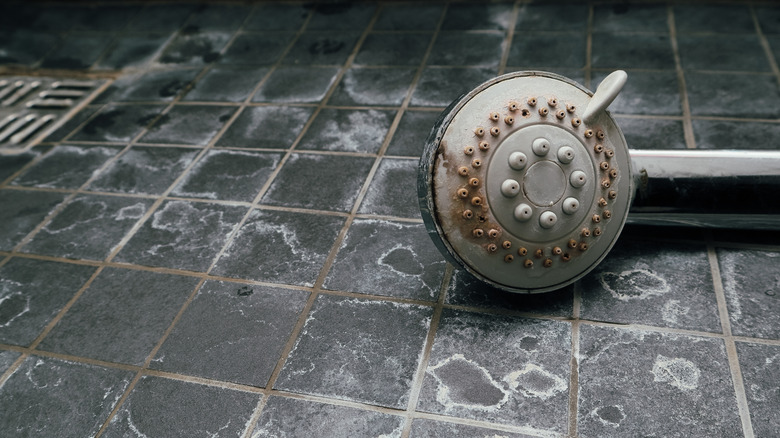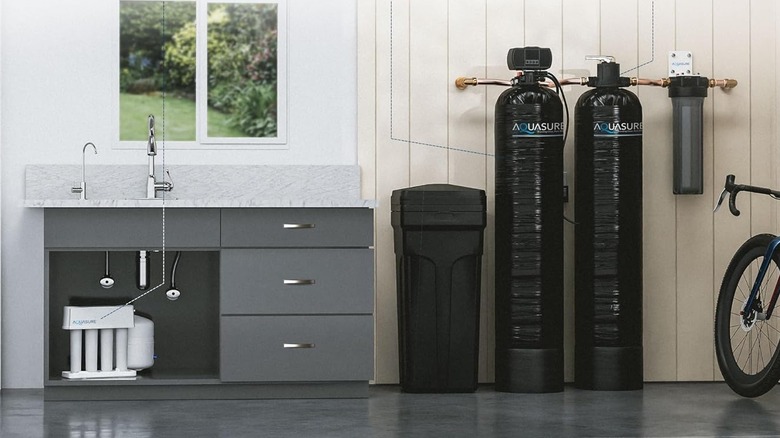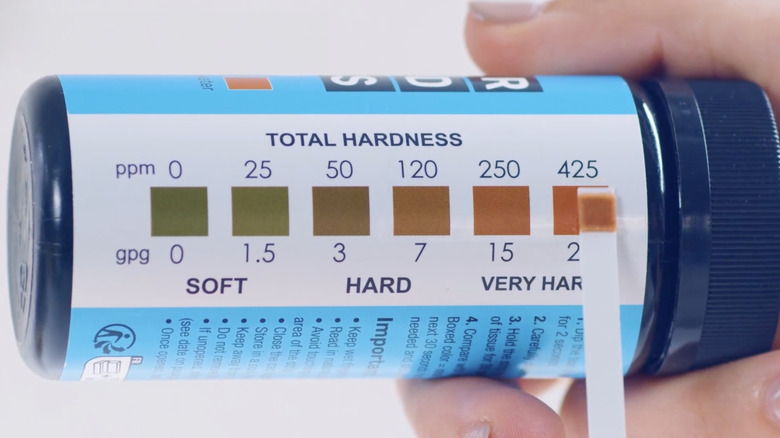Here's How Often You Should Be Adding Salt To Your Water Softener To Prevent Damage
We may receive a commission on purchases made from links.
There are some telltale signs that you need a water softener: Spots on your dishes, scaly buildup on your showerhead, or soap that doesn't lather up. This occurs because your water is "hard," which means it has lots of dissolved minerals in it. Along with these annoyances, neglecting to soften your water with salt can cause serious damage to your home because the minerals can build up over time inside your pipes, eventually leading to corrosion or other costly plumbing issues. Your home appliances can be seriously damaged by hard water, too. According to Ian Thomas, a plumber at Frontdoor, Inc., you should be checking your water softener system weekly to determine if it's time to add more salt.
"Water softeners all use salt relative to the amount of hardness that they are taking out and the volume of water used," Thomas told House Digest during an exclusive interview. "To determine when it's time to refill the brine tank, people should check once a week." Each system is a little different, but typically, the brine tank is the larger one with a removable lid that allows you to easily check the levels of both the water and salt inside. "If you can see water above the salt in the tank, then it's time to add more salt to your water softener," Thomas said. The plumbing expert explained that maintaining the right amount of salt is critical because without it, your water softener won't be able to produce soft water. According to Thomas, "Your water softener relies on the brine that is made with salt, which washes the hard minerals from the resin beads during regeneration."
Check your system frequently and replenish it with the right kind of salt
There are plenty of reasons your home would benefit from a water softener. If you have some DIY plumbing experience, it's relatively easy to install a system like the highly rated Aquasure Harmony Series Whole House High Efficiency Water Softener from Amazon by yourself. Even if you have a plumber do the job for you, according to Ian Thomas, maintaining the salt levels is something you'll need to do on a regular basis.
The process is easy. "Open the lid of the brine tank to determine the amount of salt that you have," Thomas said during his exclusive interview with House Digest. "When you need more, simply open the bag of softener salt and dump all the contents into the tank." Make sure you check the manufacturer's recommendations for the right type of salt for your system. Don't be tempted to use table salt! Instead, there are a number of specialty products available, like Diamond Crystal Solar Naturals Salt or even potassium chloride. According to Thomas, "Depending on the size of your tank, you may need three or more bags of salt." He cautioned that you should be careful when lifting the bags, which can be extremely heavy.
You should also avoid the temptation to overfill your water softener system. "A good rule of thumb is to never fill the tank more than ¾ full to reduce the chance of salt bridging," Thomas said. "[This] occurs when the salt sticks together and forms a bridge that prevents salt from falling into the water below." If this ever happens, it's important to clean your water softener brine tank to avoid damaging the entire system.
Test your water hardness before changing your softener's settings
During his exclusive interview with House Digest, Ian Thomas mentioned some additional maintenance steps you should take to prevent water damage to your water softener. Along with frequently checking the salt level and replenishing it as necessary, the plumbing expert said you should check the settings as well. "Making sure your water softener is set for the proper hardness is the most overlooked part of a water softener's installation," he explained.
"If you have a new softener or are unsure if your softener is set correctly, you can test your water with an inexpensive hardness test kit." You can buy one like the JNW Hard Water Test Kit from Amazon or your local big box store for under $20. The testing process is quick and easy, involving nothing more than exposing a strip to your water for a few seconds and evaluating the resulting color against an included chart that will help you determine the level of hardness. Thomas suggested testing before you change the settings on your water softener system, and added that you need to check with your user's manual to determine the right hardness setting for your home. "This will ensure you are properly softening the water softener without overusing salt and, in turn, possibly shortening the water softener's life."


